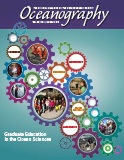Article Abstract
This article draws on several sources to provide background information on the composition of the 2015 ocean science graduate education community. We identify 148 US institutions of higher education that offer graduate degrees in the marine and ocean related sciences. Using data on degree completions and program size, the balance between master’s and doctoral programs, and the demographic characteristics of degree recipients for the 73 higher education institutions that report marine degree data to the federal government, we develop a descriptive snapshot of the 2015 ocean sciences graduate education landscape. For programs administered by members of the Ocean Sciences Educators’ Retreat community within the Consortium for Ocean Leadership, we present time-series information on the “supply side” of program dynamics (i.e., applications, enrollment), including detailed demographics, as well as an overview of curricular patterns and administrative structures. This information provides a framework that the graduate education community can use for further reflection, discussion, and collaborative action focused on the future of post-baccalaureate education in the ocean sciences.

